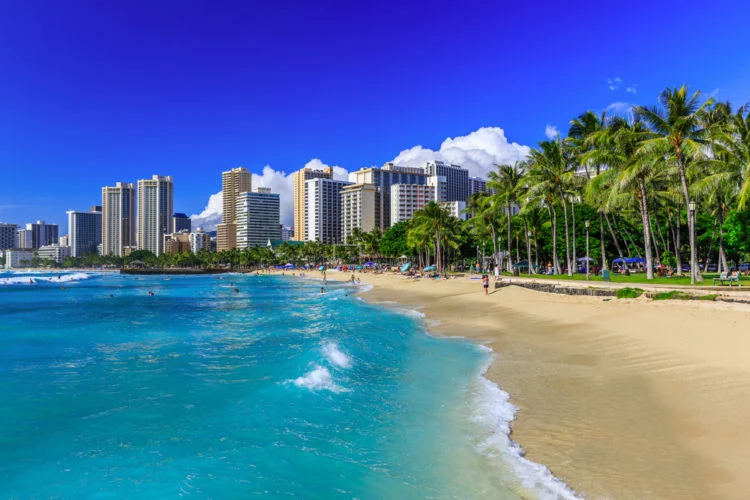Hawaii, with its stunning beaches, lush rainforests, and laid-back lifestyle, seems like an idyllic paradise. However, like anywhere else, the Aloha State has its share of areas that might be less desirable places to settle down. While these places might be fine for a vacation, factors like the high cost of living, crime rates, limited opportunities, or infrastructure issues can make them challenging for a long-term resident.
This article delves into five of the worst places to live in Hawaii, considering a range of vital aspects to help paint a more realistic picture of life beyond the tourist brochures.
1. Pahoa, Island of Hawaii (The Big Island)
- Volcanic Hazards: Located on the slopes of Kilauea, one of the world’s most active volcanoes, Pahoa faces frequent disruptions due to lava flows and earthquakes. The 2018 eruption destroyed hundreds of homes, displacing residents and causing lasting damage.
- Rural Isolation and Infrastructure: Pahoa’s remote location means limited access to essential services, including healthcare, education, and diverse job opportunities. Its infrastructure can be unreliable, with frequent power outages and road closures due to volcanic activity.
- Limited Employment Opportunities: The local economy heavily relies on agriculture and tourism, leading to a lack of well-paying and stable jobs for residents.
2. Waianae, Oahu
- Socioeconomic Challenges and Crime: Waianae struggles with high poverty rates, homelessness, and crime levels exceeding the national average. Gang activity and substance abuse are persistent issues within the community.
- High Cost of Living: Despite the socioeconomic struggles, Waianae still grapples with the high cost of living typical of Hawaii. Housing is expensive, and necessary goods and services come at a premium.
- Limited Housing Options: The affordable housing crisis is acutely felt in Waianae, leading to overcrowded living conditions and making it difficult for families to find suitable homes.
3. Kahului, Maui
- Cost of Living Crisis: Kahului has one of the highest costs of living in the United States. Housing prices have skyrocketed, making it almost impossible for many working-class residents to afford to buy or even rent a home.
- Overcrowding and Traffic: With limited space for expansion, Kahului is experiencing growing population density. This has led to severe traffic congestion, especially during peak hours, turning a short commute into a stressful ordeal.
- Environmental Concerns: Development and population growth have strained Kahului’s resources and infrastructure, contributing to pollution and environmental degradation.
4. Hilo, Island of Hawaii (The Big Island)
- Excessive Rainfall and Flooding: Hilo is known as one of the rainiest cities in the United States, receiving an average of over 120 inches of rainfall annually. This unrelenting precipitation causes frequent flooding, damaging property and disrupting daily life.
- Economic Stagnation: The closure of sugar plantations left Hilo with limited economic opportunities and a stagnant job market. Many residents struggle to find well-paying positions to support themselves and their families.
- Mold and Pest Concerns: The constant humidity creates a breeding ground for mold and pests, posing health risks and affecting the quality of life and properties.
5. Kapaʻa, Kauai
- Traffic Congestion: Limited highways and roads mean Kapaʻa regularly suffers from crippling traffic congestion, making commutes and routine errands frustrating and time-consuming. The influx of tourism exacerbates this issue.
- Lack of Infrastructure for Growing Population: Kapaʻa is growing rapidly, but its infrastructure has not adequately kept pace. This strains resources such as schools, healthcare facilities, and public services.
- Vulnerability to Natural Disasters: Like most coastal towns in Hawaii, Kapaʻa is vulnerable to hurricanes, tsunamis, and rising sea levels. Severe weather events can cause significant damage and disruption.
Important Considerations
It’s crucial to note that every place has its unique set of pros and cons. What makes an area “undesirable” for one person could be perfectly suitable for another. Factors like individual priorities, financial circumstances, and lifestyle preferences play a significant role in evaluating livability.
Here are some additional points to keep in mind:
- The Cost of Paradise: Hawaii consistently ranks as one of the most expensive states to reside in. The cost of housing, food, utilities, and transportation are significantly higher than the national average.
- Island Fever: The relative isolation and limited landmass of the Hawaiian islands can lead to a feeling of “island fever” for some.
- Cultural Adjustment: The Hawaiian culture is rich and unique. People moving from the mainland United States may require some time to adapt and feel a genuine sense of belonging.
Where to Find Better Alternatives
If you’re enamored with Hawaii but are concerned about the potential downsides of the places mentioned, consider these alternative locations:
- Smaller Towns on the Big Island: Towns like Kailua-Kona or Waimea offer a less hectic and more affordable lifestyle compared to Hilo.
- Outer Islands: Islands like Molokai and Lanai present a slower-paced, traditional Hawaiian experience with less crowding and fewer tourists.
- Less-Developed Parts of Oahu or Maui: Areas away from major tourist hubs provide alternatives on these popular islands while still offering access to broader amenities.
Sources
- Hawaii Department of Business, Economic Development & Tourism: http://dbedt.hawaii.gov/
- Honolulu Star-Advertiser: https://www.staradvertiser.com/
- The Garden Island Newspaper (Kauai): https://www.thegardenisland.com/
Conclusion
Choosing a place to live is a highly personal decision. While Hawaii is undeniably alluring, it’s essential to look beyond the picture-perfect image and understand the complexities of everyday life in different parts of the islands. Thorough research, careful consideration of your individual needs, and potentially a visit to your preferred location will help you make an informed choice about whether settling in Hawaii is the right fit for you.



